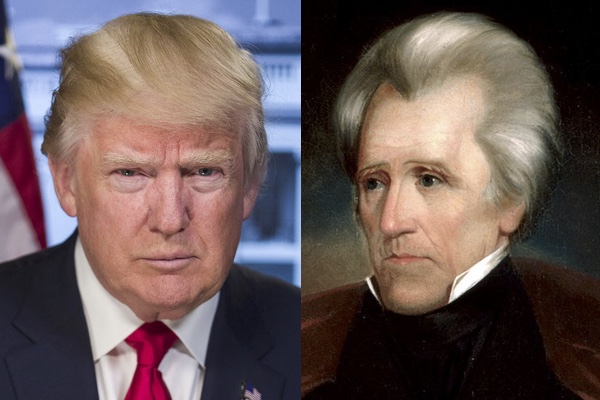Another Way in Which Trump Is Proving to Be Like Andrew Jackson – Alas

Over the weekend of October 19-20, 1973, President Richard Nixon fired Attorney General Elliott Richardson and Deputy Attorney General William Ruckelshaus when they refused to remove special prosecutor Archibald Cox. Cox had been appointed to investigate the Nixon administration’s unprecedented corruption and illegality. To replace Richardson and Ruckelshaus at the Justice Department, Nixon tapped Solicitor General Robert Bork. Bork, a loyal partisan, followed orders and illegally dismissed Cox. Dubbed by the press as the “Saturday Night Massacre,” Nixon’s purge of the Justice Department failed to stop investigations, and the infamous “Watergate” scandal forced Nixon’s resignation ten months later. Sadly, Nixon was not the first chief executive to fire his own officials in an attempt to break the law – that dubious distinction belongs to Andrew Jackson.
In 1791, when the United States was merely months old, the administration of President George Washington pushed through Congress a national bank, the First Bank of the United States (1BUS). The 1BUS was critical to post-Revolution economic recovery and prosperity, but was vehemently opposed by Jeffersonians, who deemed the bank unconstitutional. The 1BUS was allowed to expire in 1811, under President James Madison. Killing the 1BUS quickly proved a terrible error, as the Madison administration took the nation to war against Great Britain the very next year. The rush to war by an infant nation with no central bank led to a massive financial crisis. So much so, that at the war’s conclusion, those very same Jeffersonians rushed to revive the bank. Thus, the Second Bank of the United States (2BUS) was chartered in 1816 for twenty years.
Like the 1BUS, the 2BUS did wonders for the young American economy. Nevertheless, conservative extremists continued to harbor deep hatred of the institution. Opposition to the 2BUS grew especially quick among Southern enslavers of the new “Cotton Kingdom” who loathed being in debt to Yankees and Brits.1 A financial “panic” in 1819 further undermined confidence in the bank’s ability to deliver unbridled prosperity. Nevertheless, mainstream politicians avoided criticizing the 2BUS, as most Americans continued to understand its central role in their expanding economy. Even Andrew Jackson, though a powerful enslaver with a personal, deep hatred of all banks, refrained from condemning the 2BUS in his 1824 (failed) and 1828 (successful) bids for the presidency.
In 1832, however, Jackson’s challenger was Henry Clay, architect of the 2BUS and personal and political rival of “Old Hickory.” Clay, in a plan he considered fool-proof, convinced his friend Nicholas Biddle, Director of the 2BUS, to ask Congress for re-chartering early, in 1832 rather than 1836. The 2BUS would then become a campaign issue, as Jackson would either have to sign the re-chartering bill, and thus admit Clay was right, or veto the bill, removing the central pillar of the national economy. What Clay did not plan on was Jackson’s ability to manipulate public opinion. Democratic newspapers launched a massive propaganda campaign to convince the American public that the “Monster Bank” was an authentic threat to their livelihoods and the American republic: a dangerous concentration of wealth and power in the lands of the unelected few. President Jackson, Democrats claimed, would save the nation from the beast bank, just as he had saved the nation from savage Indians and the blood-thirsty Brits.
The propaganda campaign was a sensational success, and Jackson was able to win re-election and defeat Clay. Almost immediately, Jackson turned his attention to killing the 2BUS. But there was one enormous problem: the bill chartering the bank in 1816 expressly stated that the president could not remove federal deposits from the bank without Congressional approval. In other words, only Congress could kill the bank, not the president. Never a man to let laws stand in his way, Jackson ordered his Secretary of the Treasury Louis McLane to remove the deposits. When McLane argued that such a move would be illegal, Jackson replaced him with William Duane, who also refused to break the law and was fired. Finally, Jackson found someone willing to commit the crime: Attorney General Roger Taney of Maryland. Jackson installed Taney at the Treasury, the deposits were withdrawn, and the 2BUS was deprived of its power. Not only was the act illegal, but the death of the 2BUS led to financial instability, a series of dramatic economic panics in 1836-37, and finally a prolonged depression.
While the similarities are striking, it is worth noting that Jackson’s “Saturday Night Massacre” occurred over several months (not in a single weekend, as with Nixon), and concerned the Secretary of the Treasury, not the Justice Department. Nevertheless, the desperate removal of high officials and the breaking of the law by a United States president are important reminders of the limits of American democracy.
1 Loans for cotton land and slaves provided, thorough the 2BUS, by banks located primarily, though not exclusively, in New York and London. See Jessice Lepler, The Many Panics of 1837: People, Politics, and the Creation of a Transatlantic Crisis (Cambridge, UK, 2013); Walter Johnson, River of Dark Dreams: Slavery and Empire in the Cotton Kingdom (Cambridge, US, 2013); Edward Baptist, The Half Has Never Been Told: Slavery and the Making of American Capitalism (New York, 2014).